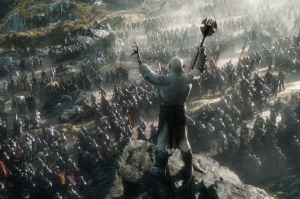★★★☆☆

“The Hobbit: The Battle of Five Armies” emerges audiences in a fantasy world of battles and dragons.
Viewers expecting a movie that continues the award-winning “Lord of the Rings” legacy will be disappointed by the third installment of “The Hobbit.” Yet while it may not match the high caliber plot and character development of its predecessor, as its own movie, “The Hobbit: The Battle of the Five Armies” is decent. Director Peter Jackson once again shows flashes of cinematic masterpiece, yet many of those moments are hampered by structural problems that come with adapting the book to a trilogy.
One of the most impressive performances of the movie belonged to a computer-generated dragon rather than a man. Benedict Cumberbatch and Peter Jackson together create Smaug, an intimidating but likeable villain. Though Smaug receives very little screen time, Benedict Cumberbatch’s distinct voice resonates with the audience. Furthermore, his movements were recorded with motion-capture technology and then translated into the body language of the digital dragon, creating an interesting contrast between the dragon’s elegant movements and its huge frame.
Peter Jackson further utilized this creature’s strong traits by using a voice-over from Smaug to show the corruption of the leading dwarf Thorin as he slowly becomes consumed by greed. As Thorin becomes more and more obsessed with gold and acquires the “dragon disease,” Jackson beautifully morphed Thorin’s voice into Smaug’s voice. While this motif may have been relied upon a little too much, it was nonetheless another show of Jackson’s remarkable creativity.
If there is one thing that Peter excels at, it his creation of awe-inspiring battle scenes that will amaze any audience. All of the major battles of the movie are visually extraordinary. The battle with Smaug is created beautifully with the burning town working as a startling backdrop. Three good characters Elrond, Saruman and Galadriel also fight together for the first time in the series and put on a beautiful display against the shadow forces of the Nazgul. The Battle of the Five Armies is the perfect climax that pits the massive armies of good and evil against each other.
These battles are all satisfying in their own way, and this action drives the movie more than anything else. Yet while the battle scenes are all set in a majestic and very appropriately Tolkien way, it is important to note that the battles have a hard time living up to those of the “Lord of the Rings.” The scenes in “The Hobbit” are geared more toward younger children, whereas its companion trilogy caters to an older audience. As a result, the battles have an unusual cartoonish tone that rids them of some of their intensity.
Despite Jackson’s impressive cinematography, the script has problems that impede character development and make the movie oddly paced. First, the development of Thorin, who is supposed to be the primary dwarf character, is hard to follow, since this installment of the movie takes place over such a small portion of the book. Thorin quickly goes from ambitious and perhaps a little misguided to completely corrupted by his desire for gold in a markedly short span of time. This was one of many problems with the breaking up of one short, continuous book into three movies.
Another problem that arose from this was the way the film dealt with the battle with Smaug. This was a moment that the story built up to across the last two films, yet it occurs within just the first few minutes of the movie. This start to the movie detracts from the emotional climax in the battle.
Other problems in the writing limited the emotional ending of the movie as well. For instance, the character Tauriel, who was created for the sake of the movie, is meant to have a forbidden romance with the handsome dwarf Kili. However, the two only have two scenes to develop their relationship, and so the sudden love between them is not germane despite the best efforts of the actors.
Another lesser character that the movie failed to develop was Legolas the elf’s father Thranduil. In “Lord of the Rings,” Legolas was one of several main characters that accompanied the hobbits on their perilous journey to protect the famous ring of Sauron. In “The Hobbit,” the movie hinted at efforts to humanize Thranduil and add character to Legolas’s lineage by mentioning reasons why Thranduil is so reluctant to enter battle, but this backstory is just mentioned briefly in a passing comment by Legolas rather than being shown in full detail.
Ultimately, the trilogy never develops many of the characters enough for viewers to become emotionally invested enough in them. The only character that people will genuinely care for by the end of the movie is Bilbo, because he is the one character who has been focused on in the adventures the entire time.
The third installment of The Hobbit does not tie up the trilogy in a beautiful way that will leave the audience in tears, but it is still a satisfying CGI-reliant movie that will leave you with one last experience of Peter Jackson’s final adaptation of the world of Middle Earth.




















fiheroe • Aug 16, 2021 at 3:54 am
its really amazing blog I like it because I got what I need from it I